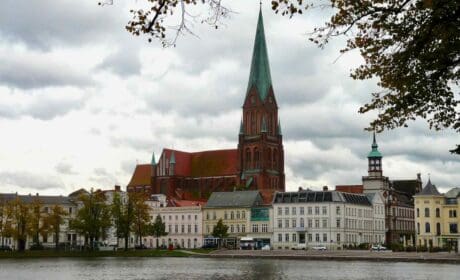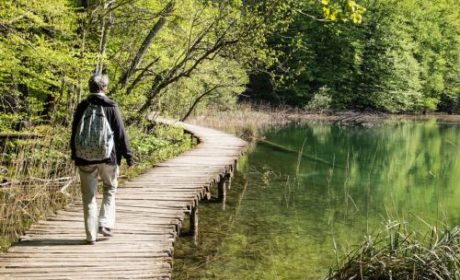Estonia may not be known as a top travel bucket list destination, but from the looks of it, it should be. Today’s guest contributor, Ann Randall spent an exciting time exploring Estonia recently and found a lovely country, full of profound history and strong spirit.
The Iron Curtain. For most Baby Boomers, what happened during the years of Soviet occupation in countries unwillingly subsumed into the former USSR remains a mystery. The Iron Curtain made sure of that. Behind it people were denied access to Western news and the ability to travel outside its boundaries. Escape was harrowing and if caught, punishable. Any travel into the country was heavily controlled by the KGB who required tourists to stay in prescribed hotels and travel in groups under the watchful eye of a KGB tour guide. Today the European country of Estonia is shedding light on that chapter of its history by promoting tourism of its former Soviet sites.
Despite the forced isolation, Estonia along with its neighbors, Latvia and Lithuania view themselves as nations unconquered during their fifty years of Soviet occupation. Pawns in the war between the Germans and USSR between 1918 and 1920, there was a two decade glimmer of independence from 1920 until the outbreak of WWII when the three countries were occupied by the Soviets in 1940-41, followed by the Germans from 1941-43 and then re-occupied by the Soviet Union from 1944 – 1991.
Upon independence in 1991, Estonia moved quickly to shake off its Soviet hackles. It was the first former Soviet republic to begin the process of becoming part of the European Union, granted in 2004. Today its medieval Old Town in the capitol city of Tallinn is a picturesque fairy tale stop for popular Baltic Sea cruises and daytrips by ferry from Helsinki, Finland. Walking the cobblestone streets or sitting in its town square filled with locals dressed in medieval grab selling souvenirs, it would be easy to forget that Soviet occupation ended only twenty six years ago. But Estonia does not want you to forget.
The country is dotted with deserted Soviet bunkers and formerly secret military towns which are open to the public, though most of them require a car, GPS and research to know the site’s history. Tallinn makes it easy to get a sense of the country’s Soviet history with museums and sites that can be reached on foot or by the capitol’s easy to navigate public transportation system. To fully grasp what happened, there is a logical order to seeing the sites that will help make sense of life in Estonia behind the Iron Curtain.
The Museum of Occupations

Located in its own uniquely designed building on the edge of Old Town near Freedom Square, the Museum of Occupations illustrates the 20th century occupations of Estonia by the Soviet Union and Nazi Germany. Laid out in chronological order with multi-language translations, artifacts and video footage, beginning a Soviet era tour here provides an important overview on how Estonia got caught in the crossfire of both world wars and a secret treaty that ultimately bequeathed the country to the Soviet Union. You’ll also read about the mass deportations of Estonians to Siberia and the escape of families by boat across the Iron Curtain, events which still impact Estonia today.

The museum also houses rotating temporary exhibitions. In March when I was there they had a pop-up museum called the Iron Curtain Project, a journalistic exhibition of all the western former Soviet countries highlighting everyday people who led the resistance movements in those countries. In the lower level was another temporary exhibit about women whose leadership contributed to changes in international diplomacy.
KGB Museum

Once you have the historical context of the Museum of Occupations, understanding the tactics of the Soviet occupation and its KGB enforcement make a logical next stop. It confirms every movie you ever saw about the Soviet security force known as Komitet gosudarstvennoy bezopasnosti.

The KGB Museum is located on the 23rd floor of Hotel Viru adjacent to Tallinn’s Old Town which was the only accomodation that foreigners could stay in during Soviet times. Advertised as a 22 floor accomodation, the KGB occupied the secret 23rd floor and from that vantage point with cameras and listening devices secretly installed in hotel rooms, they were able to secretly monitor foreign guests and communicate information to Moscow.

Sixty of the hotel’s rooms were designated for particularly “dangerous guests” – journalists, politicians and artists. In addition to the secret surveillance devices, elderly Soviet women were installed by the elevators of every floor and assigned to diligently record the comings and goings of all guests. Before the KGB vacated the building in the middle of the night of Estonian independence, they destroyed vital records and damaged recording equipment but left behind much of the remnants of their secret surveillance headquarters, including the architectural schematic of the building’s secrets. The rooms of the KGB headquarters are virtually unchanged from the condition they were left in were left in by the fleeing KGB. Tours are given regularly in multiple languages including English. Reservations can be made in the lobby of Hotel Viru.
Lennusadam Seaplane Museum and Harbor

In addition to expanding your knowledge of Estonia during Soviet times, the Seaplane Museum is a delight for fans of maritime vessels and architectural restoration. It’s a seaplane hangar built in 1916-17 and used by the Estonian Air Force. Built as the first columnless concrete dome of such volume in the world, today it is a surprisingly artistically restored museum flooded with blue lighting, overhead walkways, interactive displays and tastefully displayed boats including the remains of a 16th century Estonian ship discovered in 1985.

Additionally the museum displays small motorized boats used by Estonians to escape to Europe across the Baltic Sea during Soviet times and the sailing boats used by the Estonian Olympic team when the Soviet Union hosted the 1980 Olympics and used Tallinn for the sailing competition venue.
Looking for hotels in Estonia? We can help!
The museum is located outside Old Town on the harbor. It’s a moderate walk from Old Town, but city buses and trams stop nearby and the City Tour buses stop directly in front of the building.
Paterie Prison
Built originally as a sea fortress, the forbidding complex was turned into a notorious prison by the occupying Nazi German and Soviet forces. Up until the fall of 2016 guided tours were available of the prison but it’s been closed for safety reasons though many guidebooks and websites haven’t updated their information yet.
Tallinn’s tourism office doesn’t know if it will ever re-open as the cost of repairing the deteriorating building is expensive. The prison is located next to the Seaplane Museum. You can wander around the exterior and peek over crumbling walls to get a sense of the conditions inside. The Museum of Occupations has a permanent exhibit of Paterie prison cell doors and the stark inside of a cell.
Lauluvaljak Song Festival Grounds

Estonia calls their final 1987-1991 years of Soviet resistance, The Singing Revolution and nowhere is that revolution more apparent than the Song Festival Grounds on the outskirts of Tallinn. Dominated by a massive open air theatre, the national monument plays host every five years to an Estonian festival called, The Song of Estonia where thousands of Estonian singers and spectators gather to wear traditional costumes and sing traditional songs. Estonia is a country whose culture and pride is deeply embedded in their history of song and every school child is in a choir.
During Soviet times singing patriotic songs was a punishable offense and while the Soviets allowed the song festival to be held, the songs were strictly censored. In June of 1988 after Tallinn’s annual Old Town Festival, Estonians, in a spontaneous demonstration, made their way to the Song Festival Grounds to sing patriotic songs. By that September’s song festival, the resistance momentum had built and Estonians turned out in mass for the event. Accounts say 300,000 Estonians, a third of the country’s population, came to Tallinn to participate. In defiance of the Soviet dignitaries in attendance and KGB presence, the assembled crowd sang forbidden Estonian patriotic songs.
You can wander the grounds and pay a visit to the statue at the top of the bowl seating area. It’s Gustav Ernesaks, director of the Estonian Male Choir through the years of Soviet occupation and a leader in the fight for independence.
Watching the English made documentary, The Singing Revolution before going to the Song Festival Grounds will introduce you to the history, video footage of the festival and interviews of key Estonians who led the Singing Revolution. The Song Festival Grounds can be reached by city bus from downtown Tallinn.
Photography by Zach Allen
Have you explored Estonia? Come join the conversation at the My Itchy Travel Feet page on Facebook. Or send us an email with your thoughts.





